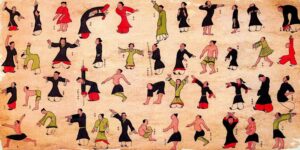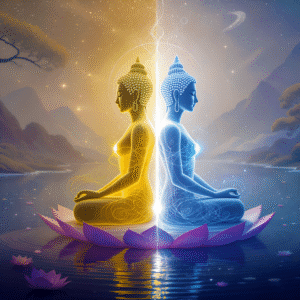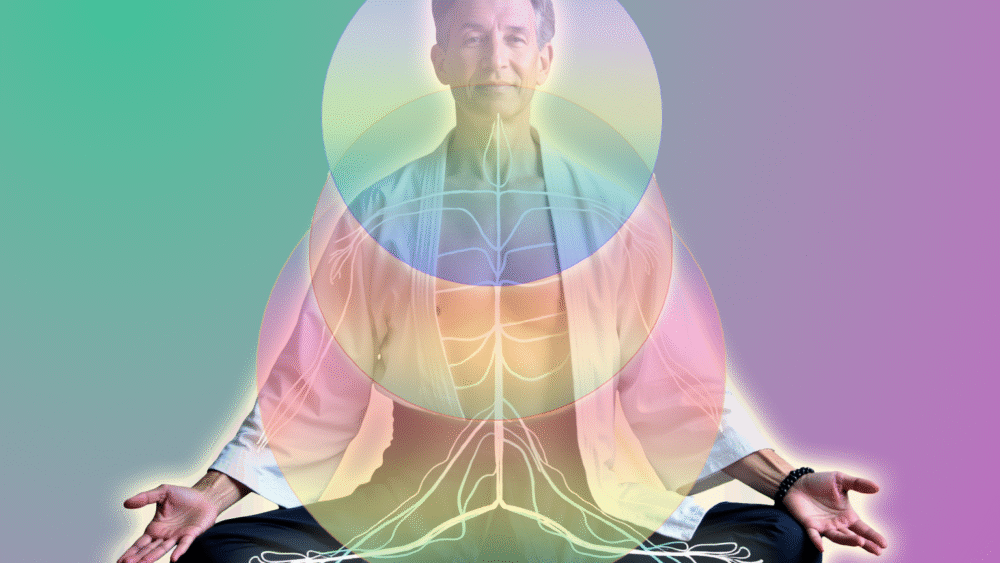Dao Yin, Qigong, and QigongDharma:
Ancient Practices for Modern Wellness
By Teja Fudo Myoo Bell
“To nourish life is to flow with the rhythms of Heaven and Earth
— this is the Dao of health and longevity.”
Understanding Dao Yin (導引)
Dao Yin (導引) is an ancient Chinese practice that combines movement, breathing, and mental awareness to cultivate health and vital energy. It is one of the earliest forms of what we now know as mind-body wellness practices—predating and forming the foundation for modern practices like Qigong, Taiji (Tai Chi), and Neigong.
Breaking Down the Name
The term “Dao Yin” is made up of two Chinese characters that reveal its essence:
• Dao (導) = “to guide” or “to direct”
• Specifically refers to guiding the flow of Qi (life energy) through the body
• Yin (引) = “to stretch,” “to draw,” or “to lead”
• Refers to leading and stretching the physical body
Together, these characters describe a practice of consciously guiding your life energy while moving and stretching your body, harmonizing breath, body, and awareness to promote health and well-being.
Dao Yin
Historical Development and Archaeological Evidence
The earliest physical documentation of Dao Yin appears in the famous Mawangdui Silk Texts, unearthed from a Han Dynasty tomb in 1973, dated to 168 BCE. The Dao Yin Tu (導引圖) is a remarkable silk scroll featuring 44 figures—men and women, old and young—engaged in dynamic movements. These images demonstrate a holistic medical system emphasizing posture, breath, and intention to treat specific ailments.

Reconstructed Dao Yin Tu (導引圖) silk scroll
Earlier written references, such as the Zhuangzi (4th century BCE), describe movements inspired by animals and natural elements, indicating these practices were part of Daoist cosmology and medicine. Some scholars trace the origins of Dao Yin to shamanic rituals and seasonal rites intended to harmonize the individual with Heaven, Earth, and Human realms—what we now call “the Three Harmonies.”
By the Han Dynasty (206 BCE – 220 CE), Dao Yin was recognized as a pillar of Yangsheng (養生)—“nourishing life”—alongside dietetics, herbal medicine, meditation, and ethical living. Prominent physician Zhang Zhongjing recommended Dao Yin practices to prevent disease and support recovery, linking them with acupuncture, moxibustion, and herbal therapy.
Core Principles and Practice Methods
Dao Yin is a somatic, energetic, and contemplative art that can be summarized into four key dimensions:
- Physical Movements – Rhythmic stretching and joint mobilization to improve fascia, spine, and muscle function.
- Breath Regulation (Tu Na 吐納) – Intentional inhaling and exhaling to regulate Qi and stabilize the nervous system.
- Mental Focus and Visualization – Awareness of inner sensations, meridian flows, or elemental imagery to strengthen the mind-body link.
- Energetic Cultivation – Synchronizing body, breath, and mind to activate and guide Qi through the meridian system.
The goal isn’t just external flexibility or muscular strength; it’s about releasing blockages, restoring natural rhythms, and harmonizing the Three Treasures—Jing (essence), Qi (energy), and Shen (spirit). Dao Yin promotes Wu Wei (無為)—effortless action—as both a principle and a felt experience. Movements emerge without force, aligned with natural intelligence, fostering ease, presence, and flow.
From Dao Yin to Qigong: Evolution and Adaptation
The term Qigong (氣功)—meaning “energy work” or “cultivation of vital life energy”— was coined in the mid-20th century. Although the practices it encompasses have existed for millennia, it was Liu Guizhen who first systematized and publicized the term in 1948, after recovering from chronic illness through traditional breath and movement exercises.
This marked a modern synthesis: a secularized, research-compatible, and nationally recognized approach to self-care. Qigong was born as an umbrella term, encompassing Dao Yin, Tu Na breathing, dynamic meditations, martial Neigong, and spiritual cultivation forms.
Understanding the Essential Distinctions Between Dao Yin and Qigong
While Dao Yin and Qigong share common roots and are deeply interconnected practices within Chinese wellness traditions, they represent distinct approaches to energy cultivation and health development. Understanding these differences helps practitioners choose the most appropriate practice for their needs and goals.
The Fundamental Orientations
Dao Yin: The Yang-Oriented, Therapeutic Approach
Dao Yin operates from a more externally focused, dynamic perspective. Think of it as the “active preparation” phase of internal cultivation:
Physical Characteristics:
• Precise, intricate movements with highly specific body mechanics
• Vigorous breathing patterns that actively mobilize energy
• Stretching and opening tissue channels to create physical space for energy flow
• Focus on extremities and external projection of energy
Therapeutic Purpose:
• Clearing impurities and releasing stagnation from the body’s energy pathways
• More yang-oriented approach that actively moves and disperses blocked energy
• Emphasis on therapeutic intervention to address specific physical and energetic issues
Qigong: The Yin-Oriented, Meditative Approach
Qigong takes a more internally focused, contemplative path. It’s the “cultivation and refinement” phase of internal development:
Internal Characteristics:
• Emphasis on internal awareness and flow
• Meditative and repetitive movements that promote deep states of consciousness
• Gentle breath, inward Qi circulation
• Integration of standing meditation, microcosmic orbit, and visualization
Cultivation Purpose:
• More Yin in orientation; cultivating and harmonizing existing energy
• Focus on building, storing, and refining internal energy rather than dispersing it
• Emphasis on meditative states and internal energy awareness
The Complementary Relationship
Dao Yin as Foundation
Many modern Qigong systems integrate Dao Yin as a preparatory or foundational phase. This makes practical sense because:
1. Physical Preparation: Dao Yin’s stretching and opening work prepares the body’s channels for more subtle energy work
2. Clearing Blockages: The vigorous, therapeutic nature of Dao Yin clears stagnation that might interfere with meditation
3. Energy Activation: The yang-oriented approach gets energy moving before the more refined cultivation work begins
Shared Benefits
Both practices support somatic re-patterning, nervous system regulation, and energetic coherence. This means they both:
• Help the body learn new, healthier movement patterns
• Regulate the nervous system for better stress response
• Create coherent energy flow throughout the body
Practical Applications
When to Choose Dao Yin
• Physical stagnation or chronic tension
• Therapeutic needs requiring specific intervention
• Preparation phase before deeper internal work
• Active, yang-type constitutions that need movement before stillness
When to Choose Qigong
• Meditation and spiritual development
• Internal energy cultivation and refinement
• Stress reduction and nervous system regulation
• Yin-type constitutions that benefit from gentle, internal focus
Many modern Qigong systems integrate Dao Yin as a preparatory or foundational phase. Both support somatic re-patterning, nervous system regulation, and energetic coherence.
The Integrated Approach
Rather than viewing these as separate practices, consider them as complementary phases of a complete internal cultivation system. Dao Yin provides the physical foundation and therapeutic clearing, while Qigong offers the meditative depth and internal refinement. Together, they create a comprehensive approach to health, healing, and spiritual development that addresses both the physical and energetic aspects of human wellness.
This understanding helps explain why many traditional and modern systems incorporate elements of both approaches, recognizing that optimal health and spiritual development often require both the dynamic clearing of Dao Yin and the subtle cultivation of Qigong.
Modern Applications and Health Benefits
Contemporary research confirms the wide-ranging benefits of Dao Yin and Qigong for physical, mental, and emotional well-being. Clinical studies and meta-analyses have shown measurable improvements in:
Physical Health Benefits
- Musculoskeletal: Improved flexibility, strength, balance, and coordination
- Cardiovascular: Enhanced circulation and heart health
- Respiratory: Increased lung capacity and improved breathing patterns
- Neurological: Better cognitive function and reduced risk of dementia
- Immune System: Strengthened immune response and faster recovery from illness or injury
Mental and Emotional Benefits
- Lower anxiety and depression levels
- Improved sleep and parasympathetic regulation
- Enhanced attention, focus, and resilience
- Reduced cortisol and systemic stress markers
- Better mood stability and emotional resilience
Recent studies on post-COVID rehabilitation revealed significant improvements in mood, fatigue, and respiratory function through Dao Yin practices.
These findings echo the timeless wisdom that movement, breath, and presence support wholeness.
QigongDharma: Living Wisdom in Practice
QigongDharma, developed by Teja Bell (Fudo Myoo Rōshi), integrates the internal arts of Dao Yin and Qigong with the meditative and ethical foundations of Dharma. As a lineage Zen master in the Rinzai tradition and a 6th-degree black belt in Aikido, Teja draws on a lifetime of deep embodiment, blending martial, medical, and contemplative training into a contemporary path of practice.
Rooted in direct experience, QigongDharma is not a belief system but a practice of “wise action” and inner freedom. It speaks to those seeking vitality, clarity, and compassionate embodiment.
QigongDharma combines the complementary streams of qigong and meditation, creating “embodied mindfulness.” This approach recognizes that we are not only physical, mental, and emotional beings but also energetic entities connected to the universal life force.
Core Elements of QigongDharma
Beyond the structural elements and practice frameworks, there are deep philosophical and experiential layers that distinguish QigongDharma as more than just a movement practice. The core elements serve as gateways to transformative states of consciousness and embodied wisdom developed over thousands of years. QigongDharma embodies “the confluence of the streams of qigong and meditation – embodiment and insight.’ This metaphor of flowing waters merging reveals something profound about the nature of practice itself. Instead of two separate disciplines being combined, they are facets of a single, undivided awareness that can be accessed through “presence awareness” – this unique contribution of QigongDharma to understanding embodied mindfulness.
The practice of “presence awareness” transcends the conventional boundaries between stillness and movement, creating what researchers now recognize as a distinctive form of consciousness characterized by ‘integrated awareness,’ often called ‘non-dual field awareness.’ This non-state involves what is described as “creating wholeness in meditative action,” where the practitioner experiences what embodied mindfulness experts refer to as “embodied awareness of the flow state of profound interconnection with all of life,” often expressed as “the Zone.”
Even so, these are among the Foundational components that make up QigongDharma practice:
Foundational Components
- Standing Qigong– Cultivating grounded energy flow and postural integrity
- Seated Dao Yin– Therapeutic breath-led stretching and mobilization
- Meditation– Zen-based mindfulness and insight practice
- Dharma Integration– Ethical inquiry and realization of interbeing
Practice Structure may include
- Centering and intention-setting
- Three Centers Breathing (Head, Heart, Hara)
- Standing movement and internal forms
- Seated Dao Yin with somatic guidance
- Meditation in stillness and silence
- Closing integration and reflective embodiment
Unique Contributions of QigongDharma
The QigongDharma approach distinguishes itself through:
Somatic Integration: Combining qigong’s energetic awareness with Zen’s mindfulness in the service of “embodied mindfulness”
Somatic Education – Drawing on neuroplasticity, trauma-informed awareness, and movement science
Therapeutic Emphasis: Drawing from his extensive experience on Zen Sesshins, Vajrayana retreats, Daoist Qigong and Martial Arts retreats, and teaching at Spirit Rock Meditation Center (over 150 retreats), Teja Bell highlights the healing and restorative benefits of practice.
Accessible Instruction: QigongDharma is suitable for practitioners of all levels, with adjustments for various physical abilities and experience levels.
Community and Continuity – Sustained online and in-person sangha dedicated to mutual support and inquiry
Living Ethics – Grounded in compassion, clarity, and spiritual responsibility
A Bridge Between Ancient and Modern Worlds
Respectful of the past and attentive to the present, QigongDharma demonstrates how Dao Yin and Qigong are not relics of the past, but living arts capable of meeting modern challenges.
They are especially relevant for:
- Aging populations maintaining vitality and function
- Stress-reduction programs in healthcare and education
- Trauma recovery and nervous system repair
- Preventive wellness and holistic fitness
- Spiritual seekers desiring embodied realization
By integrating movement, breath, mindfulness, and compassion, QigongDharma reconnects us with the natural rhythm of life. It reminds us that true wellness is not just the absence of disease but the presence of integrity, awareness, and joyful relationships.
This integration reflects the understanding that ancient wisdom traditions stay important when shared through “ethical and empowering communication” that respects their core qualities while adapting them for modern practitioners.
QigongDharma demonstrates that the future of these practices doesn’t depend on strict adherence to traditional forms and methods but involves thoughtful adaptation that keeps core principles while meeting the needs of modern practitioners. This approach honors the ancient wisdom of Dao Yin while also embracing the scientific validation of qigong’s benefits and the meditative depth of meditation practices.
QigongDharma continues to bridge these traditions, forging pathways for deeper understanding and more effective practice, ensuring that the wisdom of the past continues to serve the wellness needs of the present and future.
From ancient scrolls to modern science, the practices of Dao Yin and Qigong have endured for thousands of years because they embody universal principles: harmony with nature, cultivation of vitality, and awakening to our True Self.
Through QigongDharma, these principles find fresh expression—bridging East and West, ancient and contemporary, form and formless. The path continues, not through preservation alone, but through deep practice, clear insight, and compassionate engagement with the evolving needs of our world. QigongDharma is a living lineage of inquiry, healing, and awakening!



